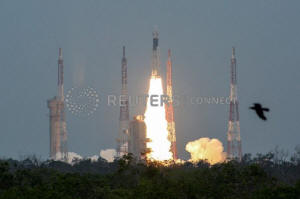India's moon mission lifts off, hopes to probe lunar south pole
 Send a link to a friend
Send a link to a friend
 [July 22, 2019]
By P. Ravikumar and Chris Thomas [July 22, 2019]
By P. Ravikumar and Chris Thomas
SRIHARIKOTA/BENGALURU (Reuters) - India
launched a rocket into space on Monday in an attempt to safely land a
rover on the moon, the country's most ambitious mission yet in the
effort to establish itself as a low-cost space power.
If successful, the 10-billion-rupee ($146-million) mission will allow
Indian scientists to carry out studies regarding the presence of water
at the moon's south pole, unexplored by any other nation before.
"This mission will offer new knowledge about the Moon," Prime Minister
Narendra Modi said in a Twitter post, praising the scientists
responsible for what he called a fully indigenous mission.
China, Russia and the United States are the only other nations to have
sent missions to the moon.

A live broadcast showed images of the rocket, carrying the unmanned
Chandrayaan-2 spacecraft, blasting off from a space center in southern
India as thousands of onlookers cheered the launch, delayed for a week
by a technical snag.
The boosters separated safely as the craft began its nearly 50-day
journey, after which the lander will attempt a controlled landing to
deploy a rover at the moon's south pole.
The spacecraft had been successfully injected into the earth's orbit,
the Indian Space Research Organisation (ISRO) said.
The next month and a half will see the spacecraft perform crucial
maneuvers to ensure a smooth landing, ISRO Chairman K. Sivan said, as
the agency's officials congratulated each other with handshakes and bear
hugs after the launch.
[to top of second column]
|

ndia's Geosynchronous Satellite Launch Vehicle Mk III-M1 blasts off
carrying Chandrayaan-2, from the Satish Dhawan Space Centre at
Sriharikota, India, July 22, 2019. REUTERS/P. Ravikumar

"We are going to experience 15 minutes of terror, to ensure that the
landing is done safely near the south pole," he told reporters,
describing the final moments before the craft is expected to land on
the moon, about 47 days from now.
The space agency has previously said the descent on the moon could
be complex, with potential problems from variations in lunar
gravity, terrain and dust having to be taken into account.
Globally, Chandrayaan-2, whose name means "moon vehicle" in
Sanskrit, will be the year's third bid at a moon landing, following
China's successful launch of a lunar probe and the Israeli Beresheet
spacecraft, which failed and crashed on the moon in April.
India's space agency suspects the south pole region of the moon
contains water in the form of ice as well as craters that could
reveal fossilized information about the early solar system.
Last week saw the 50th anniversary of humankind's first steps on the
moon in 1969.
(Writing by Sachin Ravikumar; Editing by Sanjeev Miglani and
Clarence Fernandez)
[© 2019 Thomson Reuters. All rights
reserved.]
Copyright 2019 Reuters. All rights reserved. This material may not be published,
broadcast, rewritten or redistributed.
Thompson Reuters is solely responsible for this content.
 |